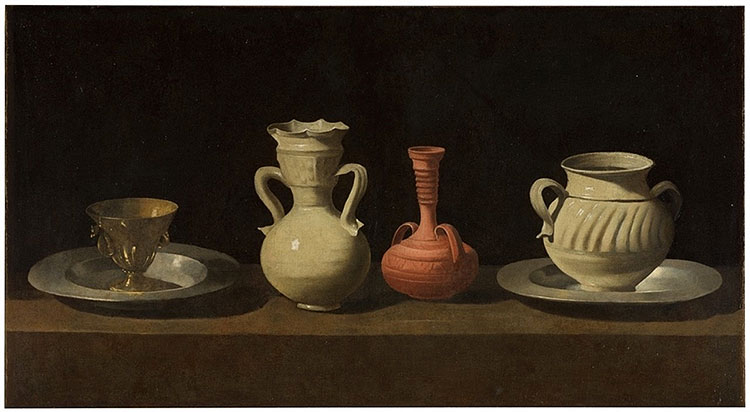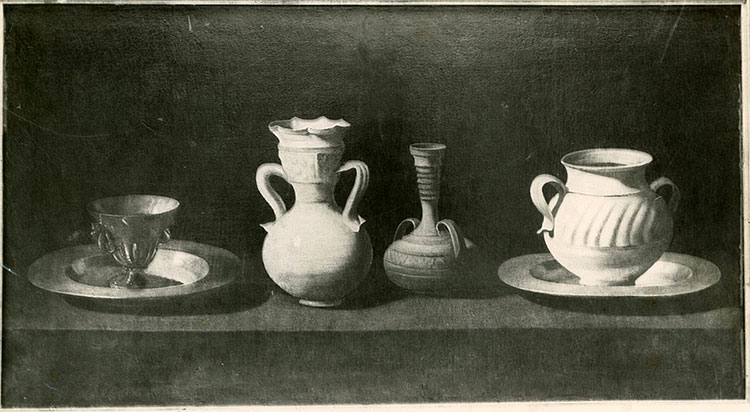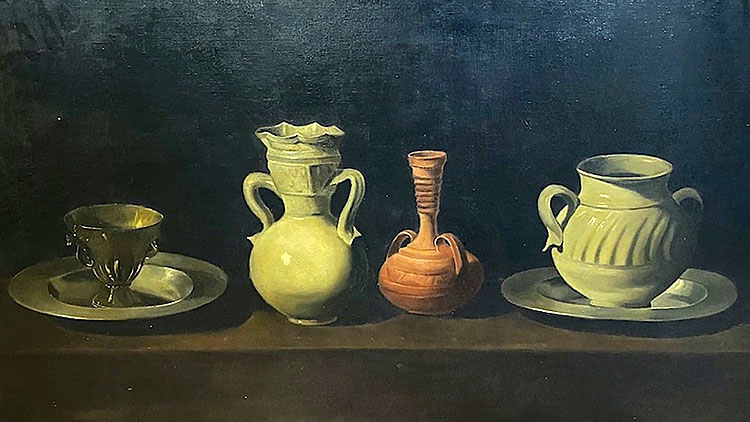The piece of the month of March 2024
A VERY PAMPLONIAN ZURBARÁN. THE IMPORTANCE OF THE COPY IN THE ARTISTIC TRAINING
Maite Dávila Mata
It was 1949 when two young women from Pamplona, Elena Goicoechea (Pamplona, 1922-2013) and Lourdes Unzu (Pamplona, 1924-2019), entered the Museo Nacional del Prado once again. Only a few years earlier, motivated, like so many other young Navarrese women, by the master Javier Ciga, they had gone to Madrid with the firm intention of continuing their artistic training . As Javier Azanza means in his study on the copying work of the Navarrese painters, the rooms of the Prado would be an essential part of this learning process.
Approximately three hundred years earlier, an elderly Zurbarán may have placed on a windowsill a pewter salvilla, on which is placed a bernegal of gilded silver, an alcarraza trianera, a búcaro de Indias and, finally, another white alcarraza de Triana on top of another pewter plate, arranged from left to right according to the description provided on the Museo del Prado's website.

Still life with pots. Zurbarán, Francisco de
Image copyright ©Museo Nacional del Prado
This still life would mark the history of art and would soon become the epitome of the Spanish still life. It is a sign of the austerity linked to convent life, so present in the work of the artist from Extremadura; far from the worldly pleasures represented not only in the Flemish, French or Italian still lifes in fashion in the 17th century, but also in the work of other Spanish still lifes such as Hiepes, Pereda or Arellano. In fact, the particularity lies in the fact that it is not a still life, there is nothing perishable in it, but rather they are elements placed to be observed, studied and analyzed. To find stillness in them, to capture the passage of time, and to invite contemplation.
In that contemplation, Elena and Lourdes searched for knowledge. In spite of already being praised by the critics as a still life painter, Goicoechea had not succumbed to the praise received for his exhibition in Pamplona in 1947 in the salons of the Diputación Foral de Navarra and continued with his formative exercises in the capital of Madrid. As did Lourdes Unzu, who a couple of years earlier, in 1947, had already repaired in this work for her study and would do so again in May 1949. From the work copy of both artists the pieces are preserved in private collections.

Still life with pots and pans. Postcard for copy
file family Lourdes Unzu
Since its foundation, the Prado Museum set out as its main mission statement example for the training of new generations, as reflected in successive regulations of the institution, while the admiration of a glorious artistic past was but a residual within its activities. This, despite the current degradation of the copy, tells us how important this action was for the training of the artists. Elena Goicoechea has a record of a first copy application in 1943, when she made two copies, San Andrés by José de Ribera and Portrait of a Man by Anton van Dyck. Both artists register consecutive copy requests, in the case of Goicoechea with number 93 and Lourdes Unzu with number 94, in October 1946, sharing an address at 51 Claudio Coello Street and Eduardo Chicharro as guarantor, a painter who cultivated the so-called 'minor genres', in addition to portraiture, all from a great sense of decorative, sumptuous and scenographic. He would come to hold management positions in important artistic institutions, among them that of Director of the Royal Academy of Fine Arts of San Fernando, where he would also teach.
To get an idea of the importance of copying in the training of the artists, let's see how in just four years these young Navarrese women explored the learning possibilities offered by the Prado Museum. Elena Goicoechea, in addition to 1943, appears in the Books of copyists and in the Index of copied painters of the Prado Museum in 1947, copying La Shrine of Our Lady of Fair Love de San Isidro en día de fiesta by Goya. Lourdes Unzu would appear a year earlier, in 1946, copying Goya's The Drunken Bricklayer. And in 1947 she would make copies of Zurbarán's Still Life with Crockery and Alonso Cano's The Virgin and Child . This process of copying in parallel of our artists, we suspect that motivated by their guarantor, will be repeated in the same way in 1949, when both of them copied again in the Prado. Goicoechea will then make a copy of Still Life with Crockery by Zurbarán and Unzu will copy La Shrine of Our Lady of Fair Love de San Isidro en día de fiesta and La gallinita ciega by Goya, again the Still Life with Crockery by Zurbarán and a portrait of Felipe IV (Felipe IV anciano) by Velázquez. In the case of Lourdes Unzu, the records of copies extend to 1951, which is also the artist's most prolific year as a copyist, with a total of 7 pieces: El pintor Francisco de Goya by Vicente López, El bufón el Primo by Velázquez, Retrato de caballero by El Greco, La Dolorosa con las manos cerradas by Titian, La Dolorosa y La Inmaculada Concepción by Murillo and, lastly, El Salvador by José de Ribera.
Understanding these pieces within these exercises and being an image in which they are repaired on more than one occasion, these still lifes take on a new dimension when put under the prism of the copying exercise. Let's see.

Still life with pots. Lourdes Unzu, 1947 or 1949
Private collection.
If you go to enquiry how to theoretically paint a still life, the rule first establishes a phase of selection of elements, which must be followed by a phase of observation of them individually and, later, as a whole, looking for a rhythm, a scale, a composition and an attractive variety in them and in their arrangement. This must be followed by the lighting, which seeks to highlight what is of interest in each element.
We can imagine Zurbarán carrying out this exercise, placing each element, treating it from its individuality, capturing the essence of each one of them, in order to, by copying the models, demonstrate his ability to adapt to the fashions of the new times; along the lines of what Trinidad de Antonio proposed: using this painting of which two copies are preserved (Museo del Prado; Museu d'Art de Catalunya) as final entertainment or training exercise in which to experiment with the narrative capacity of ordinary elements and demonstrating his imitative audacity, his technique and quality. The mastery in the use of chiaroscuro and the variety of points of view continue to hypnotize the viewer.
Like many other copyists who frequented the Madrid art gallery, the young Navarrese women found in this piece a training for their pictorial technique. In Goicoechea's work, the light blurs the contours, playing with the perception of the objects, which are not only shown in different perspectives, but are imbued with the unreality of an atmosphere of their own. Unzu's work remains faithful to the stillness of the original, which places us before a showcase stopped in time, so masterful as to be part of a collective exhibition in which he participated in 1948 organized by the City Council of Pamplona and in another individual exhibition in 1951 in the Eugui Galleries in Pamplona. The sizes differ, but neither the composition nor the extraordinary tactility of the pots vary in their recreations. By showing such skill for copying, they make us participants of the firm step with which they advanced in their training, period core topic of every artist that deserves and demands further study.

Still life with pots and pans. Elena Goicoechea, 1949
Private collection.
SOURCES AND BIBLIOGRAPHY
ANTONIO, T. DE, "Floreros y bodegones españoles en el Museo del Prado 1600-1800", in La belleza de lo real. Floreros y bodegones españoles en el Museo del Prado 1600 -1800 (coms. Trinidad de Antonio Sáenz and Mercedes Orihuela Meso), Madrid, Museo del Prado, 1995, pp. 9-35.
AZANZA LÓPEZ, J. J., "El Museo del Prado en la training de las pintoras navarras a través de los libros, registros e índices de copistas", Ars Bilduma. Journal of the department of Art History and Music of the University of the Basque Country, 12, 2022, pp. 117-139.
"exhibition of paintings in the Diputación. A great artist from Pamplona: Elena Goicoechea", Diario de Navarra, 15-6-1947, pp. 1 and 6.
LUNA, J. J., El bodegón español en el Prado: de van der Hamen a Goya, Madrid, Museo Nacional del Prado, 2008, pp. 82-83.
ZUBIAUR CARREÑO, F. J., "El maestro Ciga visto por sus discípulos", Príncipe de Viana, 237, 2006, pp. 55-68.
